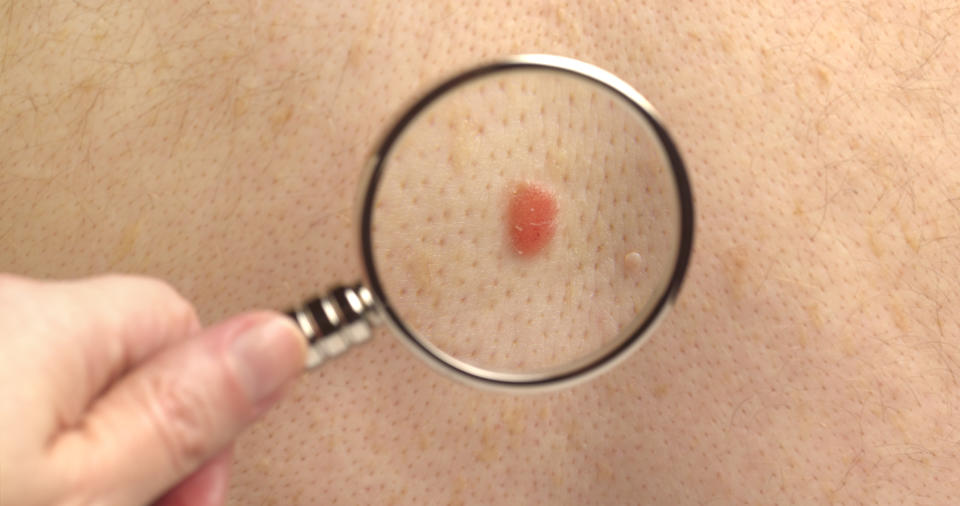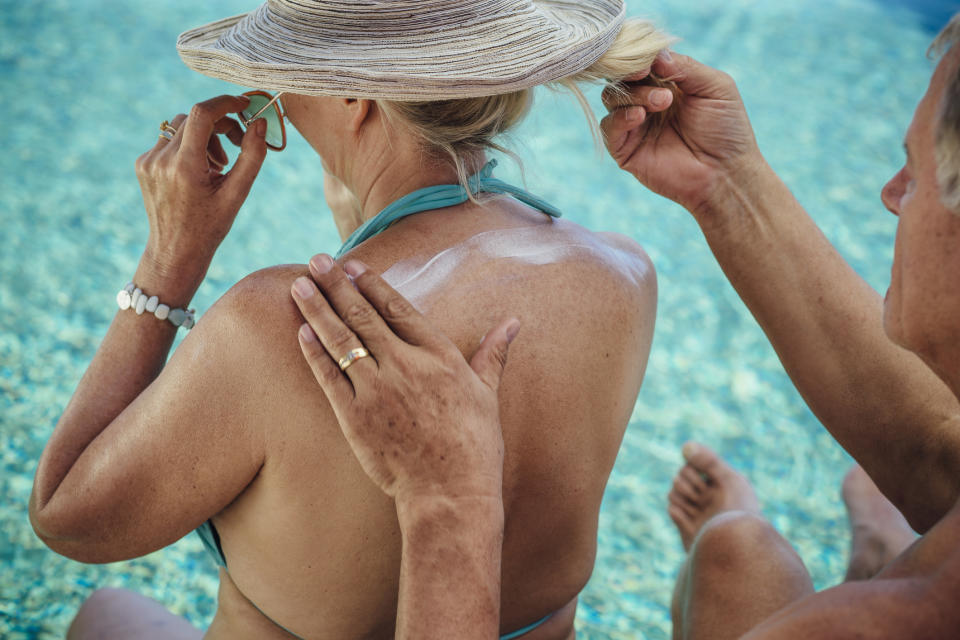Christie Brinkley Reveals Skin Cancer Diagnosis + Doctors Share How to Best Protect Your Skin
She is considered one of the most beautiful women in the world, but 70-year-old Christie Brinkley now has another moniker: cancer survivor. The model and actress revealed on Tuesday, March 13, 2024, that she’s been battling a dangerous form of skin cancer known as basal cell carcinoma. At least two million cases are diagnosed each year in the U.S. alone. Here, more on Christie Brinkley's skin cancer diagnosis, her warning to "Slather up!" and doctors' advice on how you can prevent skin cancer.
How was Christie Brinkley's skin cancer diagnosed?
Brinkley told her 899,000 Instagram followers that she’d recently had surgery to remove a cancerous lesion on her forehead and was “stitched up to perfection like a haute couture Dior.”
“The good news for you is that all of this can be avoided by being diligent with your sun protection! I got serious a bit late, so now, for this ole mermaid/gardener, I’ll be slathering on my SPF 30, reapplying as needed, wearing long sleeves and a wide-brim hat. And doing regular total body checkups is a MUST!” she shared.
Brinkley reveals that the cancer wasn’t discovered at her dermatologist appointment but actually at her daughter’s checkup, when she showed the doctor a spot she’d noticed on her face. Luckily, she caught it early before it had spread. “Make that appointment… and slather up [with sunscreen] my friends!” she urged in the post.
Doctors say Brinkley did the right thing because, like with many other cancers, early detection is critical. While two million people are diagnosed with basal cell carcinoma each year, fewer than 2,000 die from it due mainly in part to early diagnosis. “Christie has a form of cancer that typically occurs on areas of skin exposed to sun, and is thought to be caused by UV exposure from sunlight. Thus avoiding excessive sun exposure and using sunscreens on a regular basis can help prevent it,” says Christopher Choi, MD.
Related: These Nostalgic Photos of the Original ’80s Supermodels Are Filled With Glam Inspo
What types of skin cancer are there?

Skin cancer occurs when malignant (cancerous) cells develop in the skin's outermost layer. It’s important to note that while it often appears later in life, the damage can start as early as childhood. Here are the most common types and the warning signs to look for:
Basal Cell Carcinoma (BCC): Basal cell carcinoma typically appears as a small, shiny bump or nodule on the skin, often with visible blood vessels, as Christie noticed. It usually occurs on areas of the skin that are frequently exposed to the sun, such as the face, neck and hands. BCC tends to grow slowly and is less likely to spread to other parts of the body.
Squamous Cell Carcinoma (SCC): SCC is the second most common type of skin cancer. It often appears as a firm, red nodule or a flat lesion with a scaly or crusty surface. Like BCC, SCC is commonly found on sun-exposed areas of the skin. While SCC tends to grow more rapidly than BCC, it also has a higher risk of spreading to other parts of the body if left untreated.
Melanoma: Melanoma is less common than BCC and SCC, affecting 20 out of every 100,000 people, but is more aggressive and can be more deadly if not detected and treated early. Melanoma develops from melanocytes, the pigment-producing cells in the skin. It can occur anywhere on the body, including areas not exposed to the sun. Melanoma often appears as a new mole or an existing mole that changes in size, shape or color. It may also have irregular borders and multiple colors. Early detection and treatment are crucial for melanoma, as it can spread rapidly to other parts of the body.
Merkel Cell Carcinoma (MCC): Merkel cell carcinoma is a rare but aggressive type of skin cancer. It develops from Merkel cells located in the top layer of the skin. MCC usually appears as a painless, firm, red or purple nodule on the skin. It typically occurs on sun-exposed areas of the skin, such as the head, neck and arms. Merkel cell carcinoma is highly likely to spread to other parts of the body, making early detection and treatment essential.
These are the main types of skin cancer, but there are also less common types, such as dermatofibrosarcoma protuberans (DFSP), cutaneous lymphoma and angiosarcoma.
How do you know if you’re at risk for skin cancer?
According to the Centers for Disease Control (CDC), anyone can get skin cancer, but the people most at risk are those with:
Fair skin that burns, freckles, reddens easily or becomes painful in the sun.
Blue or green eyes and blonde or red hair.
A large number of moles (more than 50).
A family or personal history of skin cancer.
An extensive history of blistering sunburns.
Anyone of an advanced age.
How often should I get checked for skin cancer?
Dr. Choi says a good rule of thumb is to make an appointment with your dermatologist for a screening once a year for those with low-risk factors. If you have a higher risk of developing skin cancer, your doctor may recommend a screening as often as every 3-6 months.
What are the signs I should look for?
The signs can vary depending on the type of skin cancer. “Skin cancer typically presents as a pearly white nodule, but can also have a non-healing scab, or it could also look more like a plaque with discolorations,” says Dr. Choi.
Changes in moles: This can include moles with asymmetry or irregular borders, those larger than the size of a pencil eraser or change in size over time and varying colors or textures within the same mole. Any itching, tenderness or pain with any moles should be checked out by your doctor.
New growths or lesions: These can be firm or red, scaly or crusty, or flat and flesh colored but the telltale sign is that they don’t seem to heal within a reasonable amount of time (such as a few weeks).
What are the best ways to prevent skin cancer?

Being proactive can mean the difference between life and death. Margaret Husami, NMD, medical director at Derma Health Skin & Laser offers these preventative measures:
Stay out of the sun as much as possible between the peak hours of 10 a.m. and 4 p.m.
Cover up with long sleeves, long pants or a long skirt, a hat and sunglasses.
Use sunscreen with SPF 15 or higher (most doctors we’ve spoken to recommend a daily SPF of 30 or higher, especially on areas that are exposed all the time like hands and face).
Avoid using indoor tanning machines.
Check your skin for any changes regularly.
Eat a diet rich in antioxidants and vitamins, stay hydrated and exercise regularly. Overall health can impact skin health.
Wear sunglasses with 100% UV protection to shield your eyes and the surrounding skin from harmful rays, reducing the risk of ocular melanoma.
Apply products containing antioxidants like vitamin C, and vitamin E, which can help combat free radicals generated by UV exposure. While they don't replace sunscreen, they can provide an additional layer of protection.
Look for retinoids, derivatives of vitamin A, which are known for their anti-aging properties but can also improve skin health by promoting skin renewal and potentially reducing the risk of precancerous skin changes.
Gentle exfoliation can help remove precancerous skin cells from the surface. However, it's important to not over-exfoliate, as this can damage the skin barrier and make the skin more vulnerable to UV damage.
Using moisturizers that contain SPF can provide hydration while also offering protection against UV radiation. This is particularly useful for everyday use on the face and neck.
The lips are often overlooked in sun protection efforts but are susceptible to skin cancer. Lip balms with SPF can protect this sensitive area.
Related: This Vitamin Can Reverse Signs of Aging, Lower Cholesterol, and Reduce Your Risk of Skin Cancer
For more on sun protection, click through these stories:
“I’m a Dermatologist and *This* Is Why It’s So Important to Wear Sunscreen Year Round
